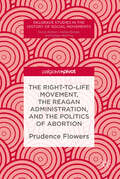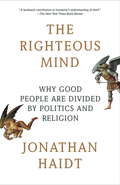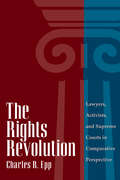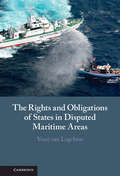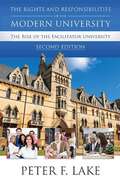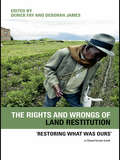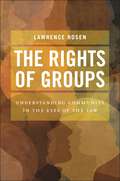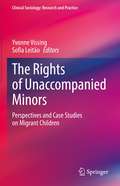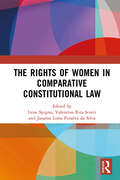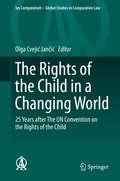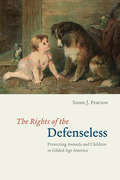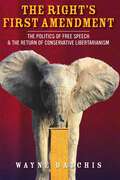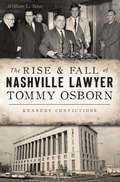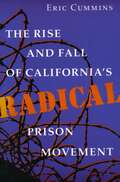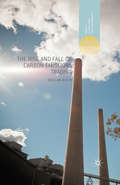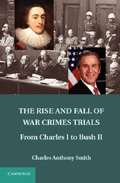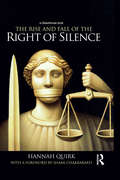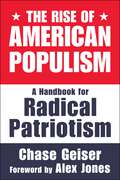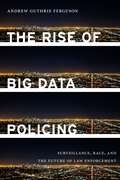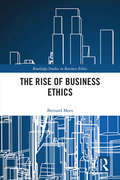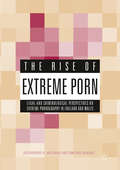- Table View
- List View
The Right-to-Life Movement, the Reagan Administration, and the Politics of Abortion (Palgrave Studies in the History of Social Movements)
by Prudence FlowersThis book offers a political, ideological, and social history of the national right-to-life movement in the 1980s under President Ronald Reagan. It analyzes anti-abortion engagement with the legislative, judicial, and executive branches, and offers what is frequently a narrative of disappointment and factionalism. The chapters explore pro-life responses to Supreme Court vacancies, attempts to pass a constitutional amendment, and broader legislative and bureaucratic strategies, including successful campaigns against international and domestic family planning programs. The book suggests that the 1980s transformed the anti-abortion cause, limiting the types of ideas and approaches possible at a national level. Although the movement later claimed Reagan as a "pro-life hero," while he was President right-to-lifers continuously struggled with the gap between his words and deeds. They also had a fraught relationship with the broader Republican Party. This book charts the political education of right-to-lifers, offering insights into social movement activism and conservatism in the late twentieth century.
The Righteous Mind: Why Good People Are Divided by Politics and Religion
by Jonathan HaidtWhy can't our political leaders work together as threats loom and problems mount? Why do people so readily assume the worst about the motives of their fellow citizens? In The Righteous Mind, social psychologist Jonathan Haidt explores the origins of our divisions and points the way forward to mutual understanding. His starting point is moral intuition--the nearly instantaneous perceptions we all have about other people and the things they do. These intuitions feel like self-evident truths, making us righteously certain that those who see things differently are wrong. Haidt shows us how these intuitions differ across cultures, including the cultures of the political left and right. He blends his own research findings with those of anthropologists, historians, and other psychologists to draw a map of the moral domain, and he explains why conservatives can navigate that map more skillfully than can liberals. He then examines the origins of morality, overturning the view that evolution made us fundamentally selfish creatures. But rather than arguing that we are innately altruistic, he makes a more subtle claim--that we are fundamentally groupish. It is our groupishness, he explains, that leads to our greatest joys, our religious divisions, and our political affiliations. In a stunning final chapter on ideology and civility, Haidt shows what each side is right about, and why we need the insights of liberals, conservatives, and libertarians to flourish as a nation.
The Rights Revolution: Lawyers, Activists, and Supreme Courts in Comparative Perspective
by Charles R. EppIt is well known that the scope of individual rights has expanded dramatically in the United States over the last half-century. Less well known is that other countries have experienced "rights revolutions" as well. Charles R. Epp argues that, far from being the fruit of an activist judiciary, the ascendancy of civil rights and liberties has rested on the democratization of access to the courts—the influence of advocacy groups, the establishment of governmental enforcement agencies, the growth of financial and legal resources for ordinary citizens, and the strategic planning of grass roots organizations. In other words, the shift in the rights of individuals is best understood as a "bottom up," rather than a "top down," phenomenon.The Rights Revolution is the first comprehensive and comparative analysis of the growth of civil rights, examining the high courts of the United States, Britain, Canada, and India within their specific constitutional and cultural contexts. It brilliantly revises our understanding of the relationship between courts and social change.
The Rights and Obligations of States in Disputed Maritime Areas
by Youri van LogchemDisputed maritime areas exist around the world, and in many cases the affected States have not been able to reach agreement on cooperative arrangements or regulate commercial activities within the area. Where a claimant coastal State increases their level of unilateral activity, such as in the South China Sea, long-standing conflicts remain difficult to resolve. This book examines the rights and obligations States have under international law concerning disputed maritime areas in the first comprehensive treatment of this highly topical and pressing issue. It analyses conventional law, general international law, judicial decisions, State practice and academic opinions that shine light on the international legal framework applicable in disputed maritime areas. Proposing practical solutions for interpreting and applying the applicable international law, the book discusses the extent to which it currently provides clear guidance to States, and how international courts and tribunals have dealt with cases related to disputed maritime areas.
The Rights and Responsibilities of the Modern University: The Rise of the Facilitator University
by Peter F. LakeThis substantially revised and updated second edition includes discussion of recent judicial, legislative and regulatory college safety mandates, modern risk management and prevention practices, and the explosion in college safety and wellness issues (suicide, active shooter violence, sexual assault, etc.) while remaining faithful to the core vision of the first edition. <p><p>The second edition also addresses the disturbing rise of a new nemesis of the facilitator university ― "Compliance U." Crushing new regulatory burdens significantly impact academic freedom and autonomy, and may interfere with the facilitator's chief goal of creating a sustainable, reasonably safe and responsible college environment.
The Rights and Wrongs of Land Restitution: 'Restoring What Was Ours'
by Deborah James Derick FayThe Rights and Wrongs of Land Restitution: ‘Restoring What Was Ours’ offers a critical, comparative ethnographic, examination of land restitution programs. Drawing on memories and histories of past dispossession, governments, NGOs, informal movements and individual claimants worldwide have attempted to restore and reclaim rights in land. Land restitution programs link the past and the present, and may allow former landholders to reclaim lands which provided the basis of earlier identities and livelihoods. Restitution also has a moral weight that holds broad appeal; it is represented as righting injustice and healing the injuries of colonialism. Restitution may have unofficial purposes, like establishing the legitimacy of a new regime, quelling popular discontent, or attracting donor funds. It may produce unintended consequences, transforming notions of property and ownership, entrenching local bureaucracies, or replicating segregated patterns of land use. It may also constitute new relations between states and their subjects. Land-claiming communities may make new claims on the state, but they may also find the state making unexpected claims on their land and livelihoods. Restitution may be a route to citizenship, but it may engender new or neo-traditional forms of subjection. This volume explores these possibilities and pitfalls by examining cases from the Americas, Eastern Europe, Australia and South Africa. Addressing the practical and theoretical questions that arise, The Rights and Wrongs of Land Restitution thereby offers a critical rethinking of the links between land restitution and property, social transition, injustice, citizenship, the state and the market.
The Rights of Groups: Understanding Community in the Eyes of the Law
by Lawrence RosenArgues that a refined concept of culture can be used by American courts to better analyze cases that cover the sense of community.Supreme Court Justices frequently justify their opinions in terms of the traditions and customs of a community. Yet, the rights and interests of entities that fit neither with the state nor the individual are treated as fluid and subjective, often existing without clarity in the current legal framework. The Rights of Groups focuses on a series of specific examples to argue that a more refined concept of culture than has been employed by American courts could offer better ways to analyze a broad range of cases that employ the notion of community.Through an original reading of the Ninth Amendment, Lawrence Rosen illustrates how a constitutional consideration for group protections might be applied to decisions arising before the Supreme Court, including the decision to overturn Roe v. Wade. Similarly, in other chapters, Rosen shows how a revised theory of culture can change the concepts—including those of “community”—that courts currently apply, whether it is the application of indigenous concepts of value to revise the statutes governing intellectual property, the importance to native peoples that burial remains be returned to the group, the role a community can play in the responsibilities attendant on the prudent investor rule, the cultural organization of Western states’ water resources, or the implementation of a new basis for group defamation suits. The book thus concludes with a call for a more sophisticated concept of culture that can sharpen our usage of the legitimate rights and interests of those entities that fit neither with the state nor the individual.
The Rights of Persons with Disabilities Bill-2016
by Govt Of IndiaThe Rights of Persons with Disabilities Bill-2016
The Rights of Unaccompanied Minors: Perspectives and Case Studies on Migrant Children (Clinical Sociology: Research and Practice)
by Yvonne Vissing Sofia LeitãoThis volume explores the various challenges faced by migrant unaccompanied children, using a clinical sociological approach and a global perspective. It applies a human rights and comparative framework to examine the reception of unaccompanied children in European, North American, South American, Asian and African countries. Some of the important issues the volume discusses are: access of displaced unaccompanied children to justice across borders and juridical contexts; voluntary guardianship for unaccompanied children; the diverse but complementary needs of unaccompanied children in care, which if left unaddressed can have serious implications on their social integration in the host societies; and the detention of migrant children as analyzed against the most recent European and international human rights law standards. This is a one-of-a-kind volume bringing together perspectives from child rights policy chairs across the world on a global issue. The contributions reflect the authors’ diverse cultural contexts and academic and professional backgrounds, and hence, this volume synthesizes theory with practice through rich firsthand experiences, along with theoretical discussions. It is addressed not only to academics and professionals working on and with migrant children, but also to a wider, discerning public interested in a better understanding of the rights of unaccompanied children.
The Rights of Women
by Namita Luthra Emily J. Martin Lenora M. LapidusThe Rights of Women is a comprehensive guide that explains in detail the rights of women under present U.S. law, and how these laws can be used in the continuing struggle to achieve full gender equality at home, in the workplace, at school, and in society at large. The Rights of Women explores the concept of equal protection and covers topics including employment, education, housing, and public accommodations. This handbook also examines the specific issues of trafficking, violence against women, welfare reform, and reproductive freedom.Using a straightforward question-and-answer format while translating the law into accessible language, this volume is a tool for individuals, lawyers, and advocates seeking to assert women's rights under the law.Now in its fully revised and updated fourth edition, The Rights of Women is an invaluable guide to finding legal solutions to the most pressing issues facing women today.
The Rights of Women in Comparative Constitutional Law
by Irene Spigno Valentina Rita Scotti Janaína Lima Penalva da SilvaThrough a comparative analysis involving 13 countries from Africa, America, Asia and Europe, this book provides an invaluable assessment of women’s equality at the global level. The work focuses on formal constitutional provisions as well as the substantial level of protection women’s equality has achieved in the systems analysed. The investigations look at the relevant gender-related legislation, the participation of women in the institutional arena and the constitutional interpretation made by constitutional justice on gender issues. Furthermore, the book highlights women’s contributions in their roles as judges, parliamentarians, activists and academics, thus increasing the visibility of their participation in the public sphere. The work will be of interest to academics, researchers and policy-makers working in the areas of Constitutional Law, Comparative Law, Human Rights Law and Women’s and Gender Studies.
The Rights of the Child in a Changing World
by Olga Cvejić JančićThis book deals with the implementation of the rights of the child as enshrined in the Convention on the Rights of the Child in 21 countries from Europe, Asia, Australia, and the USA. It gives an overview of the legal status of children regarding their most salient rights, such as the implementation of the best interest principle, the right of the child to know about of his/her origin, the right to be heard, to give medical consent, the right of the child in the field of employment, religious education of children, prohibition of physical punishment, protection of the child through deprivation of parental rights and in the case of inter-country adoption. In the last 25 years since the Convention on the Rights of the Child was adopted, many States Parties to the Convention have made great efforts to pass legislation regulating the rights of the child, in their commitment to the improvement of the legal status of the child. However, is that enough for any child to live better, safer, and healthier? What are the practical effects of this international as well as many national instruments in the everyday life of children? Have there been any outcomes in terms of improvement of their status around the world, and improvement of the conditions under which they live, since the Convention entered into force? In tackling these questions, this work presents a comparative overview of the implementation of the Convention, and evaluates the results achieved.
The Rights of the Defenseless: Protecting Animals and Children in Gilded Age America
by Susan J. PearsonIn 1877, the American Humane Society was formed as the national organization for animal and child protection. Thirty years later, there were 354 anticruelty organizations chartered in the United States, nearly 200 of which were similarly invested in the welfare of both humans and animals. In The Rights of the Defenseless, Susan J. Pearson seeks to understand the institutional, cultural, legal, and political significance of the perceived bond between these two kinds of helpless creatures, and the attempts made to protect them. Unlike many of today’s humane organizations, those Pearson follows were delegated police powers to make arrests and bring cases of cruelty to animals and children before local magistrates. Those whom they prosecuted were subject to fines, jail time, and the removal of either animal or child from their possession. Pearson explores the limits of and motivation behind this power and argues that while these reformers claimed nothing more than sympathy with the helpless and a desire to protect their rights, they turned “cruelty” into a social problem, stretched government resources, and expanded the state through private associations. The first book to explore these dual organizations and their storied history, The Rights of the Defenseless will appeal broadly to reform-minded historians and social theorists alike.
The Right’s First Amendment: The Politics of Free Speech & the Return of Conservative Libertarianism
by Wayne BatchisNot so long ago, being aggressively "pro-free speech" was as closely associated with American political liberalism as being pro-choice, pro-affirmative action, or pro-gun control. With little notice, this political dynamic has been shaken to the core. The Right's First Amendment examines how conservatives came to adopt and co-opt constitutional free speech rights. In the 1960s, free speech on college campuses was seen as a guarantee for social agitators, hippies, and peaceniks. Today, for many conservatives, it represents instead a crucial shield that protects traditionalists from a perceived scourge of political correctness and liberal oversensitivity. Over a similar period, free market conservatives have risen up to embrace a once unknown, but now cherished, liberty: freedom of commercial expression. What do these changes mean for the future of First Amendment interpretation? Wayne Batchis offers a fresh entry point into these issues by grounding his study in both political and legal scholarship. Surveying six decades of writings from the preeminent conservative publication National Review alongside the evolving constitutional law and ideological predispositions of Supreme Court justices deciding these issues, Batchis asks the conservative political movement to answer to its judicial logic, revealing how this keystone of our civic American beliefs now carries a much more complex and nuanced political identity.
The Rise & Fall of Nashville Lawyer Tommy Osborn: Kennedy Convictions (True Crime)
by William L. TabacTommy Osborn's star was rising. The young Nashville lawyer led a band of Tennessee reformers to victory in a landmark Supreme Court case. Hailed by Chief Justice Earl Warren as the most important of his career, Baker v. Carr's "one man, one vote" mandate revolutionized how Americans chose their representatives. Osborn was hired by Jimmy Hoffa to take on Bobby Kennedy for the fourth time. Unfortunately, the young lawyer met his match in Walter Sheridan, Kennedy's top aide and brilliant spymaster. Author William L. Tabac describes the extraordinary legal proceeding with the twists and turns of a modern television drama and the fall of a prominent attorney.
The Rise and Fall of California's Radical Prison Movement
by Eric CumminsThe book presents a history of the California prison movement from 1950 to 1980, focusing on the San Francisco Bay Area's San Quentin State Prison and highlighting the role that prison reading and writing played in the creation of radical inmate ideology in those years.
The Rise and Fall of Carbon Emissions Trading (Energy, Climate and the Environment)
by Declan KuchThis book presents the results of the first full-scale emissions trading schemes in Australia and internationally, arguing these schemes will not be sufficient to 'civilize markets' and prevent dangerous climate change. Instead, it articulates the ways climate policy needs to confront the collective nature of our predicament.
The Rise and Fall of United Grain Growers: Cooperatives, Market Regulation, and Free Enterprise
by Paul D. EarlFor much of the twentieth century, United Grain Growers was one of the major forces in Canadian agriculture. Founded in 1906, for much of its history UGG worked to give western farmers a “third way” between the competing poles of cooperatives like the Saskatchewan Wheat Pool and the private sector. At its peak, more than 800 UGG elevators dotted the Canadian prairies and the company had become a part of western Canada’s cultural psyche. By 2001, then known as Agricore United, it was the largest grain company on the Prairies. The UGG’s history illuminates many of the intense debates over policy and philosophy that dominated the grain industry. After the Second World War, it would be a key player as the western Canadian grain industry expanded into new international markets. Through the rest of the century, it played an important role in resolving major disputes over regulation and grain transportation policy. Despite its many innovations, the company’s final decade and eventual demise illustrated the tensions at the heart of the grain industry. In 1997, to finance the rebuilding of its grain elevator network, UGG went public and entered equity markets. While successful at first, this strategy also weakened the company’s cooperative structure. In 2007, it was purchased by Saskatchewan Pool in a hostile takeover. The disappearance of Agricore United marked the end of a century of voluntary farmer-control of the grain business in western Canada. Paul Earl’s history reveals UGG’s central role in the growth and transformation of the western grain industry at a critical period. With meticulous research supplemented by interviews with many of the key players, he also delves into the details and the debates over the company’s demise.
The Rise and Fall of War Crimes Trials
by Charles Anthony SmithThis book is the first comprehensive analysis of the politics of war crimes trials. It provides a systematic and theoretically rigorous examination of whether these trials are used as tools for political consolidation or whether justice is their primary purpose. The consideration of cases begins with the trial of Charles I of England and goes through the presidency of George W. Bush, including the trials of Saddam Hussein and those arising from the War on Terror. The book concludes that political consolidation is the primary concern of these trials - a point that runs contrary to the popular perception of the trials and their stated justification. Through the consideration of war crimes trials, this book makes a contribution to our understanding of power and conflict resolution and illuminates the developmental path of war crimes tribunals.
The Rise and Fall of the Right of Silence: Principle, Politics and Policy
by Hannah QuirkWithin an international context in which the right to silence has long been regarded as sacrosanct, this book provides the first comprehensive, empirically-based analysis of the effects of curtailing the right to silence. The right to silence has served as the practical expression of the principles that an individual was to be considered innocent until proven guilty, and that it was for the prosecution to establish guilt. In 1791, the Fifth Amendment to the US Constitution proclaimed that none ‘shall be compelled in any criminal case to be a witness against himself’. In more recent times, the privilege against self-incrimination has been a founding principle for the International Criminal Court, the new South African constitution and the ad hoc International Criminal Tribunals for Rwanda and the former Yugoslavia. Despite this pedigree, over the past 30 years when governments have felt under pressure to combat crime or terrorism, the right to silence has been reconsidered (as in Australia), curtailed (in most of the United Kingdom) or circumvented (by the creation of the military tribunals to try the Guantánamo detainees). The analysis here focuses upon the effects of the Criminal Justice and Public Order Act 1994 in England and Wales. There, curtailing the right to silence was advocated in terms of ‘common sense’ policy-making and was achieved by an eclectic borrowing of concepts and policies from other jurisdictions. The implications of curtailing this right are here explored in detail with reference to England, Wales and Northern Ireland, but within a comparative context that examines how different ‘types’ of legal systems regard the right to silence and the effects of constitutional protection.
The Rise of American Populism: A Handbook for Radical Patriotism
by Chase GeiserThe Rise of American Populism is a captivating exploration into the evolving landscape of American politics. This insightful book delves deep into the ongoing clash between traditional American values and the emerging globalist ideologies. From Chase Geiser, a writer for InfoWars and with a foreword from Alex Jones, the book offers a robust critique of the current state of American democracy, examining the cultural, economic, and political shifts that have shaped the nation. With a focus on the resurgence of populism, the book passionately advocates for a renewed sense of patriotism and individualism. It critically assesses the influence of globalist organizations on American sovereignty, urging a return to national interests and values. Written in a compelling and assertive style, this book is a call to action, seeking to inspire and mobilize those who share a deep concern for the future of America.The Rise of American Populism is not just a critique, but a bold statement on the importance of preserving American ideals in an ever-changing world.
The Rise of Big Data Policing: Surveillance, Race, and the Future of Law Enforcement (Goldstein-Goren American Jewish History)
by Andrew Guthrie FergusonPROSE Award Winner in Law & Legal Studies:&“Essential reading for anyone who wants to understand how technology is changing American policing.&” —Kirkus Reviews (starred review) In a command center in downtown Los Angeles, a digital map lights up with 911 calls, TV monitors track breaking news, surveillance cameras sweep the streets, and rows of computers link analysts and police officers to a wealth of intelligence. This is just a glimpse into a future where software predicts crimes, algorithms generate &“most-wanted&” lists, and databanks collect personal and biometric information. The Rise of Big Data Policing introduces the cutting-edge technology that is changing how the police do their jobs and shows why it is crucial that citizens understand the far-reaching consequences of big data surveillance as a law enforcement tool. Andrew Guthrie Ferguson reveals how these technologies —viewed as race-neutral and objective—have been eagerly adopted by police departments hoping to distance themselves from claims of racial bias and unconstitutional practices. After a series of high-profile police shootings and federal investigations into systemic misconduct, and in an era of law enforcement budget cutbacks, data-driven policing has been billed as a way to turn the page on racial bias. But behind the data are real people, and difficult questions remain. This groundbreaking book examines how new technologies will alter who, where, when, and how we police, and how they also offer data-driven methods to improve police accountability—and remedy underlying socio-economic risk factors that encourage crime. It is a must read for understanding how technology will revolutionize law enforcement—and its potential threat to the security, privacy, and constitutional rights of citizens. &“Ferguson teaches us not only the fault lines in how police watch us, but how we can turn the tables to use new algorithms to watch the police. At stake is nothing less than individual liberty and the democratic control of policing.&”—Jeffrey Fagan, Isidor and Seville Sulzbacher Professor of Law, Columbia University &“Ferguson has an incredible command of the many subjects that fall under the &‘big data&’ umbrella.&”—Gizmodo &“Will be indispensable to [anyone] interested in the practice of policing.&”—Library Journal
The Rise of Business Ethics (Routledge Studies in Business Ethics)
by Bernard MeesIn 1973, Daniel Bell argued that corporations in post-industrial societies increasingly needed to behave in accord with widely accepted social norms, particularly in terms of ethical behavior and social responsibility. Yet widespread criticism of business behavior was not an invention of the 1960s and 70s or a product of changing commercial norms. The key feature historically has been business scandal. Understandings of how the field of business ethics has emerged are undeveloped, however. This book is the first attempt to explain the conditions which saw a focus develop on business ethics especially in the 1960s and 70s, and how the broader field developed to encompass related notions such as corporate governance, corporate social responsibility, ethical leadership, sustainable business and responsible management education. The Rise of Business Ethics provides an introduction and analysis of the key developments in contemporary business ethics by examining them in terms of their diachronic development – the key thinkers, the key issues, the key institutions and how they each contributed to contemporary understandings of business ethics, governance and practice. Addressing the topic from a European as well as North American perspective, The Rise of Business Ethics will be of interest to researchers, academics, and students in the fields of business ethics, business and society, business history, organization studies and political economy.
The Rise of Extreme Porn
by Alexandros K. Antoniou Dimitris AkrivosThis book analyses the criminalisation of the possession of extreme pornography through ss 63-68 of the Criminal Justice and Immigration Act 2008. It documents the legislative history of the offence and offers a criminological perspective on the role of the media in the construction of the extreme pornography problem. It evaluates the elements of the s 63 offence and critically reflects upon their weaknesses. Moreover, the book presents an up-to-date account of the number of prosecutions initiated and convictions obtained under s 63 since it came into force, alongside an exploration into the corresponding sentencing trends. The first study of its kind in England and Wales since the controversial legal provisions at issue came into effect in 2009, this book contributes new evidence to the application of the extreme pornography provisions and will play an important role in shaping debates on the prosecution of similar offences in the coming years. This book will serve as an invaluable resource to all those with an interest in law, criminology, sociology of deviance, sexuality and pornography studies.
The Rise of Gay Rights and the Fall of the British Empire: Liberal Resistance and the Bloomsbury Group
by David A. J. RichardsThis book argues that there is an important connection between ethical resistance to British imperialism and the ethical discovery of gay rights. By closely examining the roots of liberal resistance in Britain and resistance to patriarchy in the United States, this book shows that fighting the demands of patriarchal manhood and womanhood plays an important role in countering imperialism. Advocates of feminism and gay rights (in particular, the Bloomsbury Group in Britain) play an important public function in the criticism of imperialism because they resist the gender binary's role in rationalizing sexism and homophobia in both public and private life. The connection between the rise of gay rights and the fall of empire illuminates larger questions of the meaning of democracy and of universal human rights as shared human values that have appeared since World War II. The book also casts doubt on the thesis that arguments for gay rights must be extrinsic to democracy, and that they must reflect Western, as opposed to "African" or "Asian," values. To the contrary, gay rights arise from within liberal democracy, and its critics polemically use such opposition to cover and rationalize their own failures of democracy.
